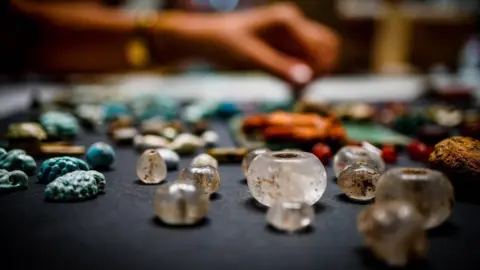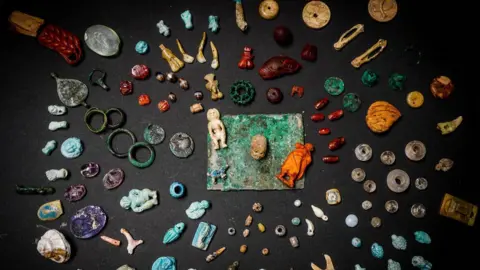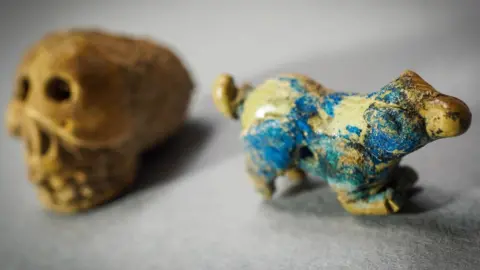Pompeii archaeologists uncover 'sorcerer's treasure trove'
 EPA
EPAArchaeologists working in the buried Roman city of Pompeii say they have uncovered a "sorcerer's treasure trove" of artefacts, including good-luck charms, mirrors and glass beads.
Most of the items would have belonged to women, said Massimo Osanna, director of the Archaeological Park of Pompeii.
A room with the bodies of 10 victims, including women and children, was excavated in the same house.
Pompeii was engulfed by a volcanic eruption from Mt Vesuvius in AD 79.
The fatal eruption froze the city and its residents in time, making it a rich source for archaeologists.
The trove was found in what remained of a wooden box. The wood itself had decomposed and only the bronze hinges remained, preserved by the volcanic material which hardened over it.
In it were crystals, ceramic, amethysts and amber. Scarabs (beetle-shaped amulets) from the Middle East were identified, along with various gems, including a carnelian with a craftsman figure and a glass bead engraved with the head of Dionysus, the Roman god of wine, fertility and ritual madness.
 EPA
EPA EPA
EPAIt was more likely the objects belonged to a servant or a slave, rather than the owner of the house, Mr Osanna told the Italian news agency Ansa. None of the artefacts was made of gold, much favoured by the wealthy of Pompeii.
"They are objects of everyday life in the female world and are extraordinary because they tell micro-stories, biographies of the inhabitants of the city who tried to escape the eruption," Mr Osanna said.
Archaeologists are now trying to establish kinship ties between the bodies found in the house via DNA analysis.
"Perhaps the precious box belonged to one of these victims," Mr Osanna speculated. The items in the box may have been worn during rituals as charms against bad luck, rather than as ornamentation, he said.
The chest was uncovered in the House of the Garden in Region V of the archaeological park - the same area where an inscription was discovered last year, indicating that the eruption may have taken place in October 79, two months later than previously thought.
The house itself would have belonged to a man of high status, confirmed by the quality of the amber and glass beads found in the trove, archaeologists say.
Most people in Pompeii were not killed by slow-moving molten lava, but by a vast cloud of hot gas and fragments, called a pyroclastic flow. The cloud surged over the city, killing its residents wherever they were, and burying them in ash, preserving their final moments.
